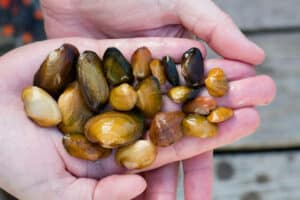Our October News to Us features articles on creatures of the Huron River: mussels and jellyfish! Links to stories on statewide dam policy development, a wastewater treatment spill in Ann Arbor, the Supreme Court’s latest Clean Water Act case, and a new study on winter nutrient runoff round out the edition.
Two years after Midland dam failures, still no action on safety reforms
Following the Edenville and Sanford dam failures near Midland in 2020, lawmakers proposed multiple bills to improve statewide dam safety and maintenance. Nonetheless, none of those legal reforms have passed or even received a hearing. However, the Michigan Department of Environment, Great Lakes, and Energy’s (EGLE) dam safety unit has been trying to fill the gaps in the interim. The unit has expanded, making more frequent site visits to the state’s dams and providing nearly $50 million in funding to support Michigan’s dam infrastructure.
1.37M gallons of partially treated wastewater spills into Huron River
In early October, the City of Ann Arbor’s Wastewater Treatment Plant discharged over 1 million gallons of mostly treated wastewater into the Huron River. The spill, which was caused by plant maintenance work, is being investigated by the plant staff and EGLE. According the the City, the discharged water went through every phase of treatment except the final ultraviolet disinfection and is not anticipated to impact public health or the environment. As a result of the incident, EGLE and the City are working to improve the plant’s notification system.
Jellyfish in Livingston County? Here’s what they are and how they got here
A species of tiny freshwater jellyfish, or Craspedacusta sowerbyi, live in waterways along the Huron. Native to the Yangtze River in China, the penny-sized jellyfish were initially introduced to Michigan waters in the 1930s via the ornamental plant trade. According to the Great Lakes Aquatic Nonindigenous Species Information System (GLANSIS), the jellyfish are not dangerous to humans but can paralyze aquatic macroinvertebrates and small fish. For more information on the ecology of the freshwater jellyfish and a map of reported sightings in the Great Lakes, visit the species profile on GLANSIS.

Freshwater mussels of Michigan: Native clams live long and fascinating lives in our lakes and rivers
This article by Michigan State University Extension explores the role of native mussels in Michigan’s waterways. With nearly 45 native species in Michigan, mussels spend their 20-30 year lives at the bottom sediments of Michigan’s lakes and riverbeds filter-feeding on bacteria and algae. As a result of development and subsequent changes to river habitat, 32 of those mussel species are at risk, with formal classifications as endangered, threatened, or special concern under the Michigan Natural Resources and Environmental Protection Act of 1994 or the federal Endangered Species Act. To learn more about the native mussels of the Huron, read our past Huron River Report article by Dr. Renee Mulcrone.
The Supreme Court case that’s likely to handcuff the Clean Water Act
After decades of confusion around what qualifies as a “navigable water” under the Clean Water Act, the Supreme Court is poised to provide clarity on which waters receive federal protection. In early October, the Court held oral arguments in Sackett v. EPA which questions the phrase “waters of the United States” in the Clean Water Act. If the Court decides to narrow the act’s scope, small tributaries, streams, wetlands, and drainage ditches could lose protection from pollution. This article from Vox explains the legal precedent, expended ruling, and potential outcomes of Sackett v. EPA.
Warming winters will thaw frozen manure, further polluting U.S. waters
A first-of-its-kind nationwide research study found that warmer winters could lead to an increase in nutrient pollution across 40 percent of U.S waters. Historically, chemicals used in industrial agriculture practices stayed locked in frozen soils throughout winter. But with warmer temperatures due to climate change, new areas of the U.S. are subject to more winter nitrogen and phosphorus runoff and subsequent impacts to groundwater and surface water quality, such as harmful algal blooms and hypoxic dead zones. Click here to learn about HRWC’s efforts to reduce agricultural nutrient pollution.



